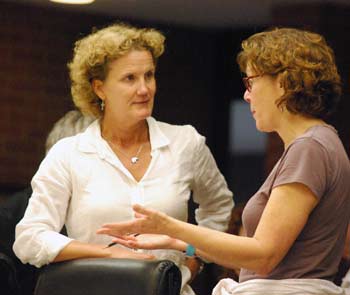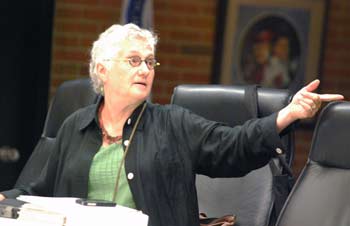R4C/R2A Committee Focuses Its Work
Ann Arbor R4C/R2A advisory committee meeting (Aug. 28, 2013): At its second of four meetings since being reconstituted by the city council this summer, the committee tasked with giving advice on possible changes to the R4C/R2A residential zoning districts moved closer to prioritizing final recommendations to deliver to the planning commission and city council.
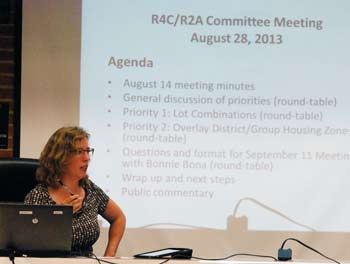
Julie Weatherbee is chair of the R4C/R2A advisory committee, which met most recently on Aug. 28, 2013. The next meeting is scheduled for Sept. 11. (Photos by the writer.)
Two main priorities have emerged as areas of concern: lot combinations, and a proposed “group housing” overlay district. Parking is also a concern, but several committee members noted that there isn’t time to reach consensus about parking recommendations. Only two more two-hour meetings are scheduled – on Sept. 11 and Sept. 25.
The committee’s original report had recommended imposing a maximum lot size of 6,525 square feet. This would limit the ability of a developer to combine lots in order to build larger structures. It would be a way to limit the size of developments within R4C districts.
The planning commission’s ordinance revisions committee made a different recommendation, however, which was adopted by the full commission. Rather than requiring a specific lot size limit, lot combinations would be approved on a case-by-case basis. Review standards would be developed, as well as standards for design and massing, to ensure that new development is compatible with the neighborhood. The planning commission has not yet developed details of how what standards would be used. Advisory committee members didn’t like this approach, saying that it seemed too arbitrary.
There are even fewer details at this point about a proposed group housing district, which planning commissioners envision as a future phase of R4C ordinance revisions. The planning commission recommendations call for a new zoning overlay district, located south and west of the University of Michigan’s central campus. It would be roughly an area outlined in the city’s Central Area Plan, but with final boundaries to be determined. [.pdf of Central Area Plan] The idea is to address issues that are somewhat unique to neighborhoods with a large amount of student housing.
In general, the new district would be intended to allow for flexibility by putting limits on density, but with premiums provided in exchange for community benefits such as pedestrian-friendly character and conformance with architectural design standards. For example, parking might be based on a building’s total floor-area ratio (FAR), independent of the number of units in a structure. The commission’s recommendations call for details of this new district to be fleshed out in a second phase, after other ordinance changes are made that are seen as more straightforward.
Advisory committee members were extremely skeptical of this approach, which one member characterized as “redlining.” Targeting housing for a particular type of resident – in this case, students – made many members uncomfortable. There was also uncertainty about the exact intention behind the recommendation.
Committee members have invited planning commissioner Bonnie Bona, who also serves on the commission’s ordinance revisions committee, to attend their Sept. 11 meeting. Their hope is to get clarity about the commission’s recommendations, as well as the intent behind those recommendations.
Several committee members stated that their overarching goal is to protect the character and integrity of existing neighborhoods, and to prevent older houses from being demolished. That’s the scenario that unfolded when seven houses were torn down along South Fifth Avenue to make way for the City Place apartments – a controversial development that was part of the impetus for the R4C/R2A review.
R4C/R2A Background
Over four years ago, on March 2, 2009, the city council directed the city’s planning staff and planning commission to review the R4C/R2A zoning districts in Ann Arbor’s “central area” neighborhoods. A few months later, in July 2009, the council created an advisory committee to provide input on the R4C/R2A zoning review. The committee’s recommendations were presented to the planning commission in a final report in May of 2012, with a set of recommendations and analysis. That report had been compiled by the planning staff. [.pdf of original advisory committee recommendations]
For the next year, planning commissioners who were members of the commission’s ordinance revisions committee (ORC) reviewed the recommendations and discussed other possible changes as well.
The ORC ultimately made a different set of recommendations, which were approved by the full planning commission at its April 16, 2013 meeting. Those recommendations were forwarded to the city council, and did not include actual wording of the proposed ordinance changes. The ordinance revisions were expected to be the next step, following direction from the council.
The planning commission’s recommendations are described in two phases. There are some significant differences from the recommendations of the advisory committee, although many of the recommendations are the same. The changes in the first phase are seen as somewhat less controversial. For the first phase, here’s how the planning commission’s recommendations diverged from the advisory committee:
- Lot combinations need approval: Planning commission approval would be required for lot combinations in R4C districts, as part of a project’s site plan review. Review standards would be developed, as well as standards for design and massing, to ensure that new development is compatible with the neighborhood. [The advisory committee had recommended imposing a maximum lot size of 6,525 square feet, equal to an allowable density of three units. The consensus on the ordinance revisions committee (ORC) of the planning commission was that this maximum lot size would be too restrictive.]
- Conflicting land use buffer for vehicle areas only: The only areas that would require screening would be those used for vehicles – such as areas used for parking. This recommendation essentially reverts to the requirements used prior to 2011, when the city instituted changes to its landscape ordinance. Those changes expanded the conflicting land use buffer requirement in R4C districts to apply to the screening of buildings, in addition to vehicular use areas. The change resulted in an increase in variance requests for redevelopment in R4C districts, given the small size of the lots. [The issue was not part of the advisory committee's recommendations.]
- Further study of R2A district: Further study is recommended – to determine if the R2A lot size should be reduced to 6,000 square feet, allowing opportunities for duplex conversions. This number is based on the lot size requirement that was in place prior to 1984, when the requirement was raised to 8,500 square feet. [The advisory committee did not recommend zoning changes in the R2A district.]
A second phase would focus on creating a “group housing” zoning overlay district, but that is recognized by planning commissioners and staff as controversial. This “group housing” district was not part of the advisory committee’s recommendations.

Carl Luckenbach, an architect and member of the R4C/R2A advisory committee, at the Aug. 14, 2013 meeting of that group.
There was sentiment by some members of the original advisory committee that their work had been cut short by the planning staff, and that the final report presented to the planning commission on behalf of the committee did not fully reflect the committee’s consensus.
So at its July 1, 2013 meeting, the city council voted unanimously to reconstitute the advisory committee, with the goal of completing its work and responding to the planning commission’s recommendations.
There are 12 members on the reconstituted citizens advisory committee, including many who served on the original committee. City councilmember Sabra Briere (Ward 1) will represent the planning commission. [Former councilmember Tony Derezinski and former planning commissioner Jean Carlberg were on the original committee.] Jay Holland replaces Chuck Carver to represent rental property owners. From the wards: Ilene Tyler and Ray Detter (Ward 1); Wendy Carman and Carl Luckenbach (Ward 2); Ellen Rambo (Ward 3); Julie Weatherbee and Nancy Leff (Ward 4); Eppie Potts and Anya Dale (Ward 5). Weatherbee is chair of the group. Michelle Derr was also appointed to represent Ward 3, but decided not to participate. Dale will be giving feedback in writing, but does not plan to attend the committee meetings.
The group is working on a tight timeline, with only four meetings scheduled. Two of those meetings have taken place so far – on Aug. 14 and Aug. 28. Both were attended by The Chronicle. In addition, meetings are scheduled on Sept. 11 and Sept. 25, from 7-9 p.m. at city hall.
More information about the R4C/R2A zoning review is on the city’s website. [.pdf of planning commission recommendations] [.pdf of original advisory committee report] [.pdf of chart by Sabra Briere outlining differences between the advisory committee and planning commission recommendations] See also Chronicle coverage: “Planning Commission Signs Off on R4C Draft.”
Priority Areas
At the advisory committee’s first meeting on Aug. 14, the group discussed priority issues to focus their work, given that they planned to meet only four times. On Aug. 28, they reviewed a summary of those priorities that had been identified at their first meeting. [.pdf of priority areas document]
Julie Weatherbee, chair of the committee, stressed the need to focus their efforts and be clear about what they’re trying to “fix.” She noted that the two main consensus priorities were: (1) lot combinations, and (2) the proposed group housing overlay district.
Nancy Leff suggested that the committee make a clear statement about why they felt these two areas were a high priority. She cited part of the original charge from the city council as one of her main concerns: “Develop site design standards that encourage creative design while maintaining sensitivity for existing neighborhood character; …” [This is one of the "priority action strategies" identified in the 1992 Central Area Plan, which is part of the city's master plan. It was highlighted in the March 2, 2009 council resolution that directed the planning staff and planning commission to review R4C/R2A zoning districts. The advisory committee was subsequently established, on July 6, 2009, to provide input to the planning commission on this process.]
Leff said that for her, the advisory committee’s work boils down to addressing that charge. With the exception of some large fraternity houses and churches, the character of the neighborhoods in R4C districts is overwhelmingly single-family homes, she said – regardless of who is actually living in those homes. “If you eliminate the single-family homes in this zone, you are completely destroying the current and original nature and character of the properties in that zone,” she said. If developers are allowed to tear down those existing homes through lot combinations or group housing, Leff added, it will “completely obliterate” what’s left of the neighborhood’s character.
Sabra Briere cautioned against calling these structures single-family homes, saying it could cause people to quibble about whether the houses are rentals or owner-occupied, or about how many people are living there. It’s the visual fabric that the city needs to protect, Briere said, but not necessarily for the original use. There can be a lot of variance in that visual appearance, depending on where the lots are located, she said. Briere thought that lot combinations should be the committee’s top priority.
Eppie Potts agreed that the committee should avoid calling the buildings single-family homes. It’s not important who’s living there now, she said. It’s important to talk about the original plats. “It’s the buildings and their lots that we’re wanting to preserve,” she said, with traditional sizes and setbacks.
Ray Detter pointed out that the council’s original charge had quoted directly from the city’s Central Area Plan, and that those statements could back up the committee’s recommendations on lot combinations and group housing.
Weatherbee noted that some of the difficulty in addressing issues within the R4C district is that there are many different types of structures there now, from large older apartment buildings to smaller homes to duplexes. Some neighborhoods have tiny lots with hardly any setbacks, while other neighborhoods have large lots and setbacks. Sometimes, even opposite sides of the street have different character, she observed.
Priority Areas: Lot Combinations
The advisory committee’s original report had recommended imposing a maximum lot size of 6,525 square feet. However, this recommendation was not accepted by the ordinance revisions committee (ORC) of the planning commission. ORC members felt that this maximum lot size would be too restrictive, and so they instead made the recommendation to handle lot combinations in R4C districts as part of a project’s site plan review, on a case-by-case basis. The ORC recommended that review standards be developed, as well as standards for design and massing, to ensure that new development is compatible with the neighborhood. This recommendation was adopted by the full planning commission, but specific standards have not been proposed.
At the advisory committee’s Aug. 28 meeting, Eppie Potts said she thought the 6,525-square-foot maximum lot size was workable. It meant that there could be some lot combinations, but they’d be relatively small. Nancy Leff noted that the number of 6,525 wasn’t arbitrary – because it had been based on a survey of lot sizes within the R4C districts, she said, and that justification was supposed to be included in the committee’s report. But the justification hadn’t been part of the report, she noted.
Ellen Rambo recalled that when the advisory committee was first formed, it focused on the issue of non-conforming lots in the R4C district – because that was the problem that had been stressed most by planning staff. The intent of the 6,525-square-foot maximum lot size was to minimize the number of non-conforming lots within the R4C district.
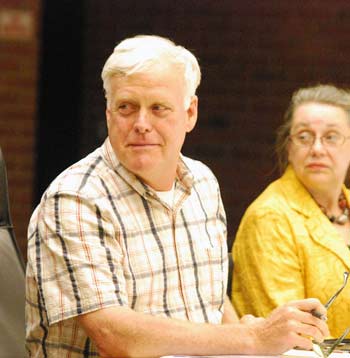
Jay Holland of Jay Holland Construction Co. and Sabra Briere, who serves on the Ann Arbor city council and planning commission.
Julie Weatherbee pointed out that the committee hadn’t wanted to prohibit lot combinations entirely, because combining lots makes sense in some situations. She wondered if the committee wanted to bring back that same number of 6,525 square feet as part of their new set of recommendations.
Ilene Tyler supported that approach. “We need a number,” she said. Under the planning commission’s proposal, all lot combinations would require the commission’s review. “Who knows what judgment or criteria they’re going to use?” Tyler said, adding that there needs to be clear guidelines.
Ray Detter felt that the ORC and planning commission want to set up an “arbitrary” approach to lot combinations, similar to the customized zoning of a planned unit development (PUD). He referred to a memo that the advisory committee had received from Jeff Kahan of the city’s planning staff regarding how to regulate lot combinations. [.pdf of Kahan's memo] The planning commission’s proposal is “exactly what Kahan seems to suggest that we shouldn’t do,” Detter contended.
Detter liked the idea of allowing a specific lot size or following the original plats. He also said he wanted to be fair to developers. He and Christine Crockett, president of the Old Fourth Ward Association, worked hard to support developer Tom Fitzsimmons for a development on Catherine Street, Detter said. It had been proposed for two vacant lots zoned R4C in an historic area, he said. If there had been restrictions on lot combinations at the time, Detter noted, Fitzsimmons had indicated that the project would not have been possible. Detter wanted to make sure that zoning would allow projects like the Catherine Street development to occur, calling it a “special case.”
Eppie Potts found it disturbing that the planning commission didn’t set any standards for making its decisions related to lot combinations. Eventually, those standards would be developed, she noted, “but meanwhile, a lot of damage is done.”
Regarding lot combinations, Jay Holland – owner of Jay Holland Construction Company – felt that problems with new developments generally relate to massing, not to the size of the lot. He also noted that some very large homes in historic districts survived, because they were converted to multi-family homes or offices.
Holland reported that he’d been around in the late 1970s and early 1980s, when the city expanded the minimum lot size in R4C districts from 6,000 square feet to 8,400 square feet. That’s contradictory to what some advisory committee members are now proposing, he said. “It seems like if it were broken, it would have been fixed long before now.”
Holland said he believed in urban redevelopment, “in a good way.” There’s a benefit to restoring structures that are deteriorating, he said, even if it means shifting the buildings and the existing lot lines. If the city makes that kind of project too difficult, “it won’t be happening,” he said.
Nancy Leff said she didn’t think she and Holland were very far apart in what they wanted. Her concern was simply the possibility that a developer could tear down multiple houses and put up a large apartment building, for example. Once built, it’s unlikely that an apartment building would be torn down in the future in order to build smaller homes, she noted. Holland replied that perhaps a developer would want to tear down old dilapidated homes in order to build newer houses – though perhaps not as many. His point was that it’s the massing that’s more of a concern.
Weatherbee told Holland that if there were more developers like him, “this town would be better off. I think the trouble is, whether it’s our processes or the people, we don’t get a lot of great projects,” she said. At this point, people might be reacting to the bad projects that have come forward, she noted.
Potts agreed that massing was an issue, and that’s why she’s in favor of limiting lot combinations. “The only reason anyone seems to want to combine lots and take down houses is to build something very massive,” she said, which violates the character of these neighborhoods. “So mass is our problem.”
The only way Potts said she can think of to prevent this is to restrict the lot combinations to a specific square footage, which probably amounts to two or three lots at the most.
Holland countered by saying that lot combinations would be needed if someone wanted to build several detached homes as part of the same development. Other committee members were supportive of that idea, but unsure how it could be accomplished. Briere asked Holland how he would write that outcome into the city code. “That’s the challenge,” she said.

Ray Detter, a member of the reconstituted R4C/R2A advisory committee. Detter was not a member of the original committee, but attended many of their meetings.
Detter brought up the City Place development on South Fifth Avenue, saying he sat through all the meetings when the project was first brought forward as a planned unit development (PUD). He said the developer threatened the city that if the PUD wasn’t approved, then a by-right project based on R4C zoning would be proposed instead. Ultimately, the project was built based on R4C zoning, Detter said, “and what we got was that awful thing [done by] combining lots.” Detter added that he wanted to revise the zoning so that no one can threaten to build anything like that again.
Holland said he was under the impression that the developer had proposed to save the existing homes there. Detter replied that such an alternative had been proposed, but it didn’t happen “because it was all baloney, and the money wasn’t there.” [By way of additional background, the city council had denied approval of the project.]
Weatherbee characterized the City Place project as “kind of a failure on everyone’s part” – a failure of the planning process, the city council, the owner, and the neighbors. People didn’t believe that the developer would be able to build a project using the existing homes along Fifth Avenue, she noted, “but we didn’t let him try it.”
City Place was a failure of the city’s process, Weatherbee said. “We don’t want our current zoning to be the worst of all options, where nobody’s really happy.” The hope would be to make it possible to have developments that everyone can live with, she said – “or something better.”
Ellen Rambo quoted from the 2009 land use element of the city’s master plan – the final sentence in this paragraph:
Action F – Reinforce residential neighborhoods in the area south and west of Central Campus by developing new zoning definitions and standards that support organized group housing opportunities. Examples of ordinance revisions include amendments to reduce nonconformities, elimination of special exception use approvals and minimum house size in some areas. Additional buffer areas between single-family and student areas may be needed. Off-street parking requirements and density limitations, however, should not be reduced in these areas.
Rambo wondered how Holland envisioned creating “friendly, livable streets” with new developments that are aesthetically pleasing. Was there a way to prevent the kind of monolithic buildings that are being constructed?
Holland replied that he’s not a designer, but he was under the impression that the planning staff, planning commission and city council are interested in developing some kind of design overlay. It takes a lot of time, he added, “and you don’t always get it right the first time.”
At the end of the meeting, the group – with the exception of Holland – reached consensus on the recommendation of limiting lot combinations to a maximum lot size of 6,525 square feet, which is 1.5 times the current minimum lot size.
Tyler noted that the original priority for the advisory committee was to try to bring more of the existing lots into conformance with zoning. “It wasn’t that we were opposing development,” she said. Currently, any time owners of a non-conforming property want to make changes, they have to get approval from the zoning board of appeals. “So it wasn’t just a protectionism angle on this,” Tyler said. “It really was a bigger gesture on our part to say that there are a lot of people who suffer, and not just single-family owner-occupants.”
Holland said he agreed with the ORC recommendations regarding lot size, not with the advisory committee. He suggested that the committee’s report could reflect the majority opinion as well as his dissent.
Weatherbee noted that she’d be shocked if the committee had 100% agreement on these recommendations. “We’re not screaming at each other – that’s one step forward,” she joked.
Priority Areas: Group Housing
In their discussion about the proposed group housing overlay district, Julie Weatherbee noted that the original advisory committee had talked about the idea of overlay districts, and had liked the idea of using those to capture the different characteristics of neighborhoods within the R4C zoning districts. But the planning commission’s proposal for a group housing overlay district isn’t one that committee members like, she said. “I personally don’t like the idea of zoning districts that are set up for certain types of people,” Weatherbee said. If you substituted a racial or gender designation instead of students, “then I would be ballistic.” Setting up a zoning for a student district makes her very uncomfortable.
Sabra Briere noted that there are currently some areas that are already zoned for group housing, but there are housing cooperatives in other parts of the city too. For group housing that’s not in an area zoned for that use, then any changes to that structure must seek variances from the zoning board of appeals, she said.
If someone wanted to establish a new residence that’s considered group housing – located in an area where that type of housing isn’t allowed – the developer would have to petition both the planning commission and zoning board of appeals, she said.
Ray Detter called the current boundaries for a possible group housing district as “malleable” and “very arbitrary.” Some areas are included that he didn’t consider student housing districts, he said, while some areas with student housing “dumps” aren’t included. [As a possible later phase proposal, details of the group housing designation haven't been fleshed out by planning commissioners or staff.]
Eppie Potts voiced concern about a lack of clarity regarding what a group housing overlay district means, compared to other possible overlays, such as those for design standards. Nancy Leff agreed, saying the proposal for a group housing district seems like a new type of zoning, rather than an overlay.
Ilene Tyler noted that some people view historic districts as a form of overlay zoning, because it crosses boundaries of different zoning districts.
Jay Holland said that in the case of historic district requirements, the restrictions related more to massing than to lot size. Leff didn’t think it was possible to separate lot size from massing.
Detter said that even if there were an overlay for group housing, development in that area should still have to conform to the requirements of R4C zoning too. The problem is that decisions related to the group housing overlay might be made by the planning commission “in almost an arbitrary way,” he said. “I don’t want that kind of situation at all.”
Briere clarified that a zoning overlay district would go on top of the underlying zoning. For example, in a group housing overlay district, it might be possible to increase the number of people per unit or per acre, she explained. But the zoning as it relates to lot combinations wouldn’t change. “The lots are restricted the way they are everywhere else in R4C,” she said. Or it might be desirable to add even more restrictions using an overlay approach, Briere said. There are some overlay areas in the D1 district that restrict building height more than the standard D1 regulations, she noted.
An overlay district is designed to be non-arbitrary and enforceable, Briere said, as well as clearly understandable and predictable. “That we haven’t managed that yet is a shame.”
Based on Briere’s explanation, Leff replied that the group housing proposal “violates all those principles, because there are no regulations or standards.” Briere pointed out that the planning commission plans to develop those standards in the second phase of these revisions.
Potts felt the only rationale for a group housing overlay would be to create more density, and she expressed skepticism about the approach. Detter quipped: “You don’t want a fraternity next to your house.”
Weatherbee again stressed that this is a topic that the advisory committee needs to explore with Bonnie Bona, because none of the committee members are comfortable with the vague proposal. Bona, a member of the planning commission’s ordinance revisions committee, is expected to attend the Sept. 11 meeting of the advisory committee.
Priority Areas: Parking
Parking was another concern raised by advisory committee members. But committee chair Julie Weatherbee told the group that she didn’t think they’d be able to reach consensus on that topic, given their time constraints. She felt the best approach might be to give some general guidance, rather than a detailed recommendation for parking.
Ilene Tyler wanted to recommend against having the planning commission introduce any change to the existing parking regulations.
Ray Detter felt that residential parking permit programs were effective in controlling parking in the neighborhoods. He suggested that might be a strategy deployed more widely in R4C districts. He noted that enforcement is still a problem, however.
Eppie Potts said she felt strongly about the parking issue. She felt parking regulations could be used to address the problem of six-bedroom student apartments. When developers don’t have to provide parking, she said, they can build a larger structure with more bedrooms per unit.
Related to the six-bedroom concern, Sabra Briere wondered why the previous advisory committee hadn’t recommended that the city put a limit on the number of people per unit that a development could accommodate. Tyler reported that the committee had talked about it, but they couldn’t reach consensus so it was not included in the final report.
Potts noted that the committee had also made parking recommendations that didn’t get included in the report.
Weatherbee added that the committee had decided to let the planning staff take the lead on some of these issues, and as a result, some of the recommendations got “derailed.” She said she didn’t blame staff, noting that the committee had been complicit in this approach.
Jay Holland thought that the parking requirements for high-rise developments “have really put a burden on the neighborhoods.” It’s not fair that smaller, existing home have to provide more parking, proportionally, than large apartment buildings with more residents. The same disparity also applies to setbacks, he said.
The advisory committee will likely take up the issue of parking at a future meeting.
Questions for Ordinance Revisions Committee
At the advisory committee’s initial meeting on Aug. 14, the group discussed differences between its original recommendations – presented in a report that was delivered to the planning commission in May of 2012 – and the ultimate recommendation of the planning commission’s ordinance revisions committee (ORC), which was approved by the full planning commission and forwarded to city council. They also noted that some of their recommendations didn’t make it into the final advisory committee report, which was prepared by Matt Kowalski of the city’s planning staff. Committee members felt that in some cases, that report didn’t accurately reflect the advisory committee’s actual consensus.
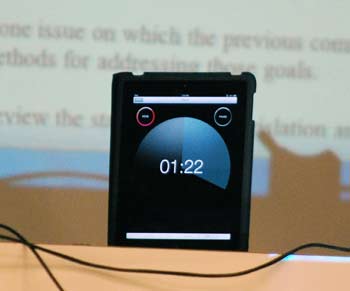
At the suggestion of Julie Weatherbee, the R4C/R2A advisory committee members agreed to limit their speaking turns. They were given 2 minutes per turn. Weatherbee used her iPad as a timer.
In their discussion on Aug. 14, several advisory committee members had questions about the intent and meaning of some of the ORC’s recommendations. Ultimately, the group decided to invite a member of the ORC to one of the advisory committee meetings, to answer questions and help get clarity on some of these issues. Committee members talked about which ORC member might be best suited to handle the questions. Ray Detter suggested either Bonnie Bona or Kirk Westphal, saying that he did not want Diane Giannola to come. [Westphal is running for city council in Ward 2. Wendy Woods also serves on the ORC.]
The group reached consensus that Bona would be invited to attend. Julie Weatherbee, chair of the advisory committee, suggested providing questions to Bona in advance of the meeting, so that Bona wouldn’t be “blindsided.”
Although the hope was for Bona to attend the Aug. 28 meeting, she couldn’t make it until the group’s session on Sept. 11. So on Aug. 28, advisory committee members spent part of their meeting discussing possible questions for Bona. [.pdf of draft questions]
The main concerns focused on the proposed group housing overlay, with committee members questioning the purpose of such an overlay, as well as concerns over a lack of details and the targeting of a specific group – in this case, students. Nancy Leff called it a kind of redlining. Detter added that the committee isn’t opposed to overlays that protect the scale and character of the neighborhoods, but they are opposed to the creation of a student neighborhood.
Eppie Potts said the overarching question for Bona should be: Why did the ORC make the recommendations that it did? Detter added that the committee is really asking Bona to justify the ORC’s positions. When he has asked Bona in previous conversations about the rationale, she indicated that it was based on the city’s central area plan, Detter reported. “At this point, it’s not our job to simply put in everything that’s in the central area plan,” he said. “It’s our job, at least as far as this committee is concerned, to preserve the character and scale of the R4C areas.”
Several committee members suggested narrowing down the number of questions, so that there would be time for Bona to answer, along with time for some dialogue. Briere volunteered to compile a shorter set of questions for Bona.
Public Commentary
Three people spoke during the opportunity for public commentary at the end of the Aug. 28 meeting.
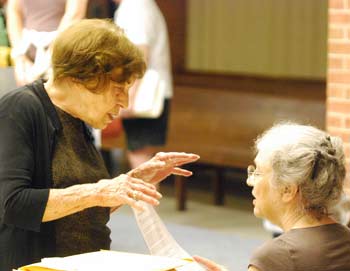
Eppie Potts, a member of the R4C/R2A advisory committee, talks with resident Eleanor Linn prior to the committee’s Aug. 28 meeting.
Eleanor Linn said she had several notes, but that the committee had addressed all of the topics she was interested in. She noted that not all of the draft questions for Bonnie Bona were appropriate, and some should be answered by city staff – questions about legal issues, for example. Linn also wanted to make sure the committee asked Bona about what problem these zoning revisions are trying to correct. That would be good to know, she said, rather than guessing the intent of the ORC.
Gwen Nystuen characterized the committee’s discussion as good. The issue of group housing is a big one, she said, and it’s unclear what is meant by that. Nystuen was happy to see that there seemed to be unanimity on the committee that a student overlay district was not appropriate. Nystuen joked that she has lived next to a fraternity for about 50 years, so she’s familiar with group housing.
Regarding group housing, Christine Crockett said it’s important to avoid designating zoning for a particular demographic, such as students. “It’s creating a ghetto – saying that this is the senior citizen part of town, or this is the Asian-American part of town.” It’s a way of encouraging people where to live, Crockett added, and “that’s a very dangerous direction to go in.”
One issue that concerns her is the demolition of older houses, Crockett continued, even houses that could be rehabilitated. That’s what bothered people more than anything regarding the City Place development, she said. So it’s more than just a simple issue of lot size. She noted that Tom Fitzsimmons, for example, has taken down houses in the city’s central area and built new structures that are more suburban in nature – and he didn’t have to combine lots to do that. She said it was alarming when you have the bullnose of a garage facing the sidewalk, where there once was a porch.
Crockett also thought the committee needed to be more specific. “The more vague your recommendations are, the more it’s going to be interpreted by the planning commission,” she said. The committee needs to imagine the worst possible scenario, she added, “because that has happened in this town.”
Julie Weatherbee asked Crockett for an example of a specific recommendation. R4C neighborhoods vary widely, Weatherbee noted, so what’s appropriate for one neighborhood might not be appropriate for another. In her neighborhood, Weatherbee said, all of the houses have porches, but in some neighborhoods they don’t.
Crockett replied that for the most part, all houses originally had porches. Ilene Tyler noted that houses built after the mid-1920s or 1930s don’t necessarily have porches. Linn added that her house was built in 1914 and it doesn’t have a front porch, because the house is rotated on the lot – so the side of the house faces the street.
Weatherbee asked Crockett if she was referring to design specifics. Crockett replied that she’d like the committee to include a recommendation that discouraged the demolition of houses. She noted that a house of historical significance had been demolished in the north central area, and replaced with a house “that’s so suburban looking, it’s offensive” – even though it fits the current zoning.
Committee members present: Sabra Briere, Ellen Rambo, Julie Weatherbee, Ilene Tyler, Ray Detter, Nancy Leff, Eppie Potts, Jay Holland.
Absent: Wendy Carman, Carl Luckenbach.
Next meeting: Wednesday, Sept. 11, 2013 at 7 p.m. in the basement of city hall, 301 E. Huron St., Ann Arbor. [Check Chronicle event listings to confirm date]
The Chronicle survives in part through regular voluntary subscriptions to support our coverage of publicly-funded entities like the city’s planning commission. If you’re already supporting The Chronicle, please encourage your friends, neighbors and coworkers to do the same. Click this link for details: Subscribe to The Chronicle.




